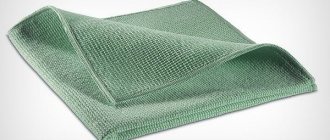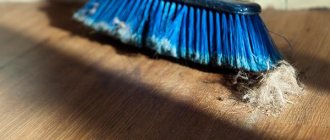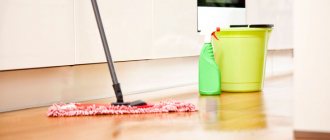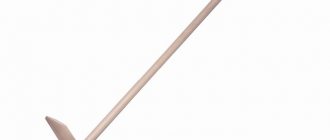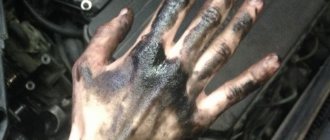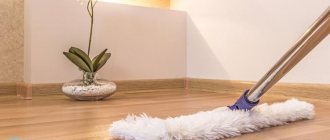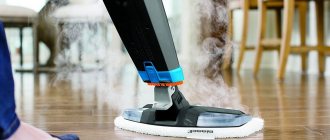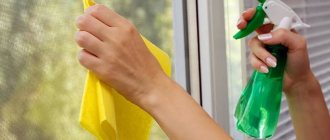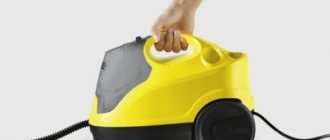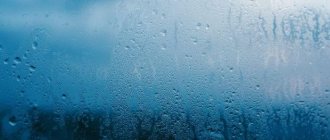For a good housewife, a rag for washing the floor is an extremely important item. Not only the appearance of your home, but also the health of your family depends on the cleanliness of your floors. Wet cleaning is responsible for the cleanliness of the air we breathe. To make this process easier, you need to choose the right cleaning items. An old terry towel or a piece of grandma's robe does not meet modern requirements. Hateful stains may remain on glossy tiles or smooth laminate surfaces.
General tips for choosing a rag
In specialized stores for household goods, the shelves are crowded with a wide range of products. The texture of any material has certain properties, so the operating conditions of the rags also differ.
A cleaning rag must combine two qualities: How to choose a rag for cleaning the floor?
- quickly absorb water;
- be soft.
Rags are made from various materials (natural and synthetic). “Homemade products” made from old things do not meet the requirements for cleaning modern premises. Nowadays, there is an entire industry that produces various home products that meet individual needs. The choice depends on the material with which the floor is covered. It can be parquet, laminate, linoleum or tile.
After washing the floors with a special rag at least once, you will not go back to using the old towel. Modern materials have a number of undeniable advantages:
- easy to do push-ups;
- do not smear dirt, but absorb it;
- collect dust well;
- do not leave streaks on glossy floors;
- do not crumble, do not leave lint on the washed floor surface;
- serve for a long time.
The price for such products is not too high, so it’s worth trying at least once to get a comfortable and durable “helper” for the house.
Recommendations
When choosing and using rags for cleaning the floor, you should consider the following tips:
- In addition to rags made from one type of fiber, mixed options are available on sale. For example, viscose with polyester. The functionality of the material will be influenced by the percentage of their occurrence.
- It is best to dry rags in the open sun, on a balcony or in a room with good ventilation.
- A specific storage area for rags must be allocated. The best option is in cabinets or on a rod located under the sink.
- A rag that has become unusable and does not perform its stated functions needs to be replaced.
Material selection
A wide range is created to make it easier to choose a product, but in some cases this leads to confusion for the buyer. It is not so easy to choose the right cloth for cleaning your floors. Rags are made from natural or synthetic material. Each of them has its own advantages and disadvantages. We will talk about the following fabrics:
- cotton;
- viscose;
- polyamide;
- acrylic;
- microfiber.
The latter material can be considered innovative. Appearing on the household goods market relatively recently, it managed to win the hearts of many housewives.
We recommend: Industrial and home care products for lacquered furniture
Synthetics to help housewives: features of use
Microfiber is a unique material
Synthetic materials, developed in the last century, have universal characteristics. They are suitable for cleaning any floor - they are strong and durable, often able to withstand repeated washing in hot and very hot water without compromising quality.
The price of such rags is slightly higher than cotton or viscose ones, but they can last much longer. Several types of raw materials are used for their production: acrylic, microfiber and polyamide.
Cotton
Cotton is a good helper when performing general cleaning in the house. Natural fabric demonstrates excellent moisture absorption and breathability. In addition, it is pleasant to the touch. However, the benefits don't end there.
Of all natural fabrics, cotton stands out for its comparative strength. The threads along the edges do not fray even without additional processing. Such rags do not stretch and easily survive repeated washings.
Despite the list of advantages, cotton rags have a number of disadvantages:
- wipe quickly;
- shrink after heat treatment;
- lose shape during cleaning;
- may leave divorces.
Cotton rags with the addition of polyester are durable and leave fewer streaks on the parquet.
Why T-shirts can't be used as rags
Clothes are not the best items to use to clean floors or other surfaces. For example, if you take your daughter's old T-shirt or towel, you may doom her to loneliness. The same applies to old shirts, pants, towels and other unnecessary things. The problem is not just marriage. It is more serious in nature. This can lead to health problems that you will have to live with for the rest of your days.
How can you wash floors? Esotericists are united on this issue. They say that you need to buy a rag from the store. This is the best option, which will not entail any negative consequences. If you don’t want to spend money, then you can take old cotton curtains or other neutral things that are not directly related to you and your loved ones.
Viscose
Viscose is a representative of the group of synthetic fabrics. For cleaning floors, they do not use a fabric resembling silk, but a porous material made from viscose fiber. The main quality is increased strength, which significantly extends the service life. Viscose is sold not only in individual packages, but also in rolls. In this case, the price will be indicated per linear meter.
The material is obtained by processing cellulose. The process is environmentally friendly. Unlike cotton, viscose rag has a number of features:
- higher hygroscopicity (absorbs moisture better);
- does not leave lint or threads on the floor due to its smooth surface;
- does not lose shape after washing;
- does not fade, does not lose its appearance.
Among the disadvantages, housewives note instability to high temperatures. When using such a product, the water in the rinse bucket should be cold. The second drawback is the remaining stains when trying to clean an excessively dirty floor. This can be avoided by choosing a rag that contains viscose and polyester.
Which rag to choose for washing floors
The quality of cleaning largely depends on the rag for washing the floor. The wrong material will not absorb water and collect dirt. It will only spread dirt across the surface, leaving streaks.
Old clothes are not meant for cleaning. Often it is too hard, quickly becomes dirty, deteriorates, and does not wash well. Therefore, more and more housewives are abandoning their grandmother’s methods of cleaning their apartments, giving preference to special floor wipes.
What parameters to pay attention to when choosing floor rags:
- Absorbency. The fabric should absorb moisture well.
- Ability to collect dirt and grease. Not all flooring materials that are presented in the store are capable of absorbing grease. Natural materials clean oily marks best, but they become more dirty. Synthetic fabrics repel fat, but collect dust well and are easy to wash.
- Durability. Synthetic fabrics are more durable than natural ones.
- Rigidity. The softer the cloth, the better it cleans uneven surfaces and penetrates hard-to-reach areas.
- Hygiene. Some materials (such as bamboo) have the ability to inhibit the growth of bacteria. Such products are suitable for children's rooms.
- Size. This parameter depends on the size of the premises. For a standard apartment, products measuring 50 by 60–75 cm are best suited. For small rooms (bathroom, toilet), it is convenient to use square napkins measuring 30 by 30. Industrial cleaning involves the use of large floor rags. The most popular size in this case is 80 by 100.
- Hairiness. A high-quality floor napkin should not crumble.
In stores you can find floor cloths made of different materials. Each of them has its own advantages and disadvantages.
To view the review:
Viscose
Viscose is an artificial material that is obtained by chemically processing cellulose. In turn, cellulose is obtained from natural wood. This is an environmentally friendly material whose properties are similar to cotton.
Viscose fabric is suitable for cleaning any floors. What is sold in stores is not a variety that resembles silk, but a porous material that absorbs water well.
Advantages of viscose rag:
- High hygroscopicity. The material absorbs water even better than natural silk.
- Durability. The fabric does not fade, does not lose its attractive appearance and does not stretch after long washes.
- Strong weave and smooth surface. Viscose does not fray when used. Thanks to this, no lint or fabric pieces remain after washing the floors.
Viscose also has its disadvantages. Among them:
- Requirements for temperature indicators. To clean with a viscose cloth, use water at a temperature no higher than 30 degrees. In a hotter liquid the material will deteriorate.
- Possibility of divorce. The problem arises if you use a viscose cloth to wash heavily soiled surfaces.
To reduce the likelihood of streaks, choose rags that are a mixture of viscose and polyester.
Cotton
Cotton is a natural, environmentally friendly material. Cotton wipes for cleaning floors are quite expensive. The price is justified by a number of advantages:
- Hygroscopicity. The material absorbs moisture well. Easy to push up.
- Fat absorption. Cotton can be used to easily remove greasy stains from the floor. This material is suitable for kitchen floors.
- Weaving strength. The material does not crumble, even if the edges are not processed. It does not leave any loose threads or fabric pieces.
- Hygiene. Cotton rags can be boiled. They are not afraid of chemicals and bleaches. Suitable for cleaning in medical institutions.
- Hypoallergenic. The material does not cause allergies.
- Tactile sensations. The fabric is pleasant to the touch.
Not all housewives like cotton floor napkins. They have disadvantages:
- Fragility. The material wears out quickly. Dyed material fades with frequent washing. White canvases take on a gray tint.
- Shrinkage. After boiling or washing the floors in hot water, the fabric shrinks.
- Divorces. They remain if you wash very dirty floors with cotton cloth.
As with viscose, when combined with polyester, cotton leaves fewer streaks. Mixed material is considered an ideal option for cleaning parquet.
Polyamide
Polyamide is a synthetic material characterized by high wear resistance. This rag lasts for more than 5 years, during which time it does not fade, does not deform, and does not change its original appearance.
The fabric is resistant to mechanical stress. Does not wear out over time. It does not tear even with strong stretching and twisting due to its elasticity.
The fabric has a small pile. It is light and pleasant to the touch. Absorbs and releases moisture well.
The only disadvantage of the material is its high cost. Many housewives believe that the disadvantage pays off due to its long service life.
Acrylic
Acrylic is a durable material made from natural gas. It has an affordable price, bright color and attractive appearance. Has a fleecy surface.
Advantages of acrylic rags:
- Durability. Acrylic does not fade, does not wear out, and does not deform over time.
- Strength. The fabric is difficult to tear. It does not lose lint when used.
- Hypoallergenic. The fabric does not irritate even sensitive skin.
- Chemical resistance. Acrylic rags are not afraid of exposure to alkalis and acids.
The only drawback of acrylic napkins is that they do not absorb moisture at all. Therefore, the material is used for polishing (rubbing) wooden, parquet, and laminate surfaces.
HPP
KhPP is a non-woven stitched canvas fabric. Made from short strands of cotton held together with a zigzag stitch.
The fabric can be found in rolls 50 m long and 55–180 cm wide or in cut form. There are two types of such textiles: white and colored:
- The first option has a higher price and is made exclusively from cotton (usually virgin) threads.
- The second option is made from cotton waste. Often a large amount of synthetics and even crushed plastic are added to the composition.
CPP rags are most popular among housewives due to a number of advantages:
- Low price. Non-woven cloths are cheaper than most natural and synthetic options.
- Chemical resistance. Suitable for all floor cleaning products.
- High absorbency. The fabric absorbs water, grease, other liquids, and dust well. The napkin releases moisture well and dries quickly.
- Does not leave threads or other particles on surfaces.
The disadvantage is its unattractive appearance and fragility. Such rags will have to be changed frequently.
Microfiber
Microfiber is considered one of the best options for cleaning all non-kitchen surfaces. The material consists of thin fibers and has many fibers.
Benefits of microfiber:
- Hygroscopicity. The material easily absorbs and releases liquid (4 times better than any other textile).
- Interesting design. Microfiber cloths are made in bright colors that do not fade over time.
- Strength. The material does not tear and does not lose lint.
- Durability. The rag does not lose its attractive appearance and does not wear out over time.
Disadvantages of microfiber:
- Inability to absorb fat. When interacting with fat, all the benefits of the napkin are canceled. This option is not suitable for the kitchen.
- Accumulation of static electricity. Requires more frequent washing than other rags.
- Heat intolerance. To wash microfiber floors, use cool water.
Bamboo
Bamboo napkins are made from fibers of the plant of the same name. They easily absorb water and grease without additional detergents.
Dirt from them can be easily washed off with running water. They are distinguished by their depravity and durability. The only drawback is the high cost.
Acrylic
The production of this material is based on natural gas. Acrylic is resistant to shape. It feels like wool to the touch. The material is hypoallergenic, retains color, and does not deform when interacting with acids and alkalis.
Advice
Do not use acrylic for wet cleaning.
A significant disadvantage is low hygroscopicity. The fabric is practically airtight and absorbs water very poorly. Because of this, acrylic rags are used for rubbing floors with a shiny surface (parquet or laminate), and not for wet cleaning.
How to extend service life?
In order for rags to serve for a long time and not present unpleasant surprises, it is important to adhere to the following rules:
- Cleaning tools should be stored for storage only after washing and drying, since a dirty wet rag can be a source of unpleasant odors and the development of pathological microorganisms.
- It is best to wring out store-bought rags rather than wring them out. This will prevent fiber deformation and rapid wear.
- The cleaning product should be used for its intended purpose. If you use it, for example, to wipe off technical oils, then the thing will quickly become unusable.
- It is better to dry it flat out in the air or in places with good ventilation.
- Store in a dry place.
Polyamide
Another type of synthetic cleaning cloth. Polyamide is very elastic, it dries quickly and is resistant to mechanical stress. Even after repeated cleanings, its shape and color remain unchanged. The fabric is pleasant to the touch, light and airy. A significant plus is resistance to fungi and rotting.
We recommend: Is it possible to clean carpet with a household steam cleaner?
Among the disadvantages of this material, one can only note the rather high price. However, as reviews from satisfied housewives show, the price is very justified.
Generalization on the topic
As you can see, knowing the characteristics of a particular material, it is not difficult to make the right choice. Whatever floor cloth you choose, to ensure it lasts a long time, you need to take proper care of it. After use, the rags must be washed in warm water, rinsed, and then thoroughly dried. You cannot dry them on the radiator. Any of the presented materials can be washed in a washing machine at a temperature of 30-40 degrees, but they should be disinfected first.
- How to pour concrete on a floor?
- Using basalt mesh
- Luxury bed linen in Moscow
- Office chair comfort affects productivity
Comments and reviews on the material
Where and how to store cleaning rags
Even household scraps require care and attention. Basic rules for operating such products:
- Wash and dry rags thoroughly after use. The washed product can be disinfected in the microwave (1 minute at maximum power is enough).
- Change it in a timely manner so that the napkin does not become a breeding ground for bacteria. Bamboo products last up to six months, microfiber and latex - 1-2 months, viscose and cellulose are intended for one use.
- Choose a place and storage devices.
DIY storage devices
To ensure that rags do not take up much space and are always at hand, the store sells ready-made shelves, hooks and hangers. You can build them yourself:
- Organizer. Partitions cut out of cardboard are glued into the shoebox. The drawer with compartments can be stored in the pantry, kitchen cabinet or bathroom.
- Clothes pins holders. A piece of double-sided tape is attached to the cabinet door, and a clothespin is glued to it. The holder is ready.
- Hanger. 2 plastic hooks are glued to the cabinet door using double-sided tape, and a string with a roll of paper towels strung on it is put on them.
By applying the suggested tips and life hacks, you can make cleaning easier and more enjoyable.
